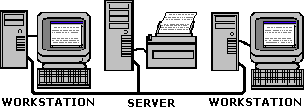The Function of a Network
A basic network consists of two or more computers connected to each other by cable. Computers that are connected to the network can send messages or email back and forth, and can share data, applications, and peripherals. A peripheral is a resource such as printer, modem, disk drive, or other hardware device. Before networks people shared data files on floppy disks and each computer needed its own printer.
LANs WANs and MANs
A network that connects together computers in a small area such as a single building or a floor within a building is called a local area network (LAN). A network that connects together computers over a large geographic area, such as different cities is called a wide area network (WAN).
Peer-to-Peer Network

There are two types of networks, peer-to-peer and server based. A peer-to-peer network is also referred to as a workgroup. In a workgroup each user administers their own computer. Security is implemented by setting the sharing or by setting a password on a resource. There are typically fewer than ten computers in a peer-to-peer network. Although it may be less expensive to implement and administer than a server based network, the server based network has better security.
Client/Server Network

A server is a computer that is dedicated to performing one or more specialized functions in the network. File and print servers manage users access to files and printers. Application servers manage users access to applications. A server-based network allows central administration of network resources and security.
More Networking Basics:
• Virtualization For Dummies Cheat Sheet
• What You Need to Know About a Career as a Network Engineer
• NRZ, NRZI, Manchester Encoding, What Does it Mean?
• What is Port Forwarding?
• Wireless Networking Your PC
• Network Patch Panel Basics
• Cellular WAN (Wide Area Network) or Mobile Broadband
• Wireshark and Ethereal Network Protocol Analyzer Toolkit
• Packet Switching Store-and-Forward Transmission
• Media Access Control (MAC) Sublayer of the OSI Data Link Layer

